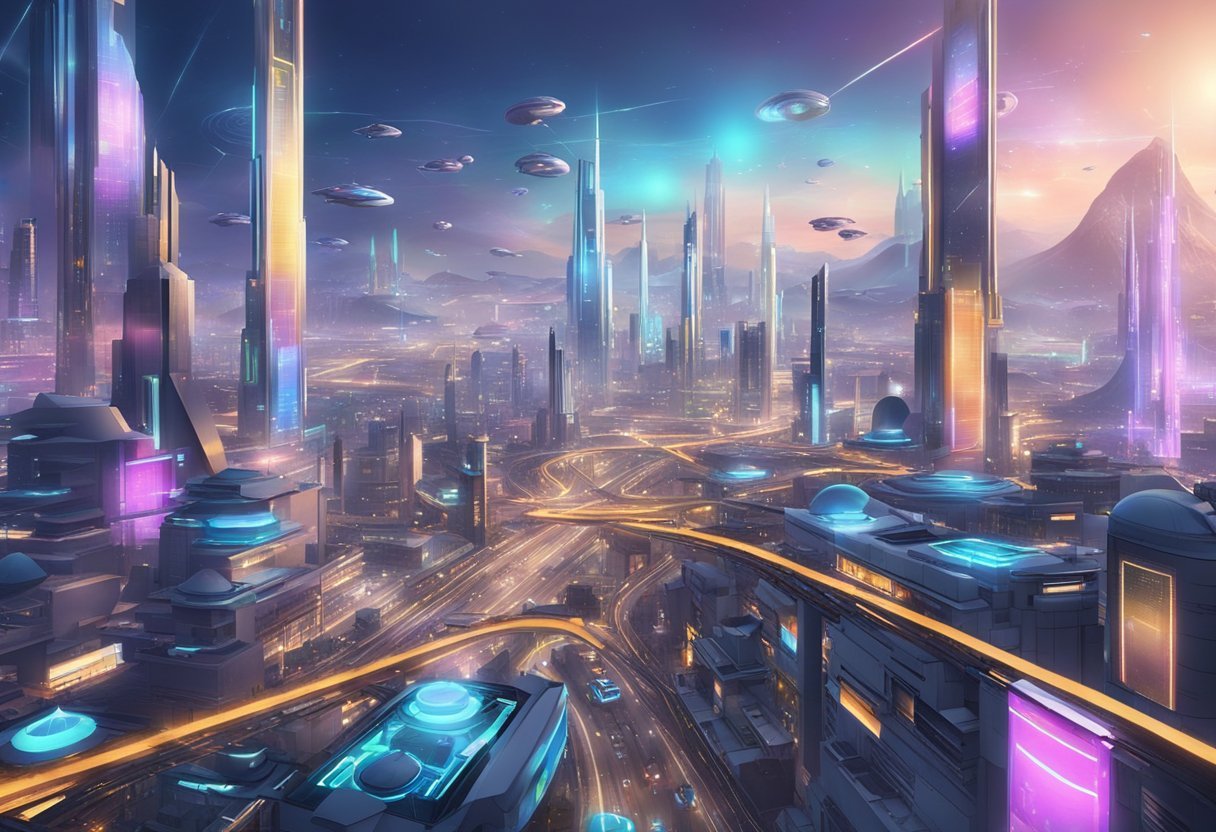The metaverse is a term used to describe a virtual world that is accessible to anyone with an internet connection. It is a place where people can interact with each other in a fully immersive environment, using avatars to represent themselves. The concept of the metaverse has been around for decades, but recent advances in technology have made it more feasible than ever before.
Metaverse 101 is an introduction to the concept of the metaverse, including its history, key components, and potential applications. The metaverse is not just a 3D version of the real world, but a fully dematerialized version of physical space, objects, and distance.
It is a persistent and immersive simulated world that is experienced in the first person by large groups of simultaneous users who share a strong sense of mutual presence. The metaverse can be fully customized, allowing users to create their own virtual environments and experiences.
Key Takeaways
- The metaverse is a virtual world accessible to anyone with an internet connection.
- It is a fully immersive environment where people can interact with each other using avatars.
- The metaverse is a persistent and immersive simulated world that can be fully customized.
Metaverse 101
The metaverse is a term used to describe a virtual world that connects users to digital space. It is an immersive and persistent simulated world that allows users to interact with each other in real-time. The metaverse is an evolution of the internet, and it is driven by people’s desire to integrate their digital and physical realities more seamlessly.
Historical Context and Evolution
The concept of the metaverse was first introduced in Neal Stephenson’s 1992 novel Snow Crash. The novel describes a virtual reality world where people can interact with each other in a shared digital space.
Second Life, a virtual world launched in 2003, was one of the earliest examples of a metaverse. The metaverse has since evolved, and today, it is being driven by advancements in technology such as 5G, cloud computing, and big data.
Technological Foundations
The metaverse is built on a foundation of various technologies, including augmented reality (AR), virtual reality (VR), blockchain, artificial intelligence (AI), and the internet.
Unity, a game engine, is often used to create virtual worlds. Smart glasses and extended reality (XR) devices are used to enhance the immersive experience. The metaverse is also powered by various blockchain technologies such as non-fungible tokens (NFTs) and virtual currencies.
Key Components and Terminology
The metaverse has several key components, including virtual worlds, avatars, digital assets, and virtual economies. Virtual worlds are digital spaces where users can interact with each other in real-time.
Avatars are digital representations of users that can be customized to reflect their personalities. Digital assets are items that can be bought, sold, and traded within the metaverse. Virtual economies are economies that exist within the metaverse and are powered by virtual currencies.
In conclusion, the metaverse is a virtual world that allows users to interact with each other in real-time. It is built on a foundation of various technologies, including AR, VR, blockchain, AI, and the internet.
The metaverse has several key components, including virtual worlds, avatars, digital assets, and virtual economies. It is an exciting technology that has the potential to revolutionize the way we interact with each other and the digital world.
Metaverse Experiences

The metaverse offers a wide range of experiences that cater to different interests and needs. These experiences can be broadly categorized into social and cultural dynamics, economic and business models, and educational and professional applications.
Social and Cultural Dynamics
The metaverse provides a virtual space for people to interact, socialize, and play. It offers an immersive experience that allows people to connect with others from different parts of the world.
Social media platforms and video games are some of the most popular metaverse experiences. They allow people to socialize, interact, and play in a virtual environment. The metaverse provides a platform for entertainment and gaming, which is appealing to a wide range of people.
Economic and Business Models
The metaverse has created a decentralized economy that allows for ownership, entrepreneurship, and the use of crypto and NFTs. It offers a platform for business owners to connect with customers and clients from different parts of the world.
The metaverse also provides a platform for ownership and entrepreneurship, allowing people to create and sell
their own virtual assets. The use of crypto and NFTs has revolutionized the way people buy and sell digital assets.
Educational and Professional Applications
The metaverse provides a platform for learning and connecting with others in a professional setting. It offers tools that enable people to work, play, and learn in a virtual environment.
The metaverse has created a new way of learning, allowing people to connect with others from different parts of the world and learn from them. It also provides a platform for professionals to connect with clients and colleagues from different parts of the world, allowing for collaboration and innovation.
In conclusion, the metaverse provides a wide range of experiences that cater to different interests and needs. It offers a platform for socializing, interacting, and playing, as well as a decentralized economy that allows for ownership, entrepreneurship, and the use of crypto and NFTs. It provides a platform for learning and connecting with others in a professional setting.
Technical and Ethical Considerations

Infrastructure and Interoperability
The metaverse is a complex system that requires a robust infrastructure to support its operations. This infrastructure includes networking, devices, and apps that enable users to access the metaverse.
Interoperability is also an important consideration, as different platforms need to work together seamlessly to provide a seamless user experience.
To ensure interoperability, the metaverse needs to have a set of standard rules and guidelines that govern how different platforms interact with each other.
This includes the use of a shared ledger to track user data and transactions across different platforms. The government may also play a role in regulating the metaverse to ensure it operates within ethical and legal frameworks.
Privacy, Security, and Governance
Privacy and security are crucial considerations in the metaverse. User data is a valuable asset, and it needs to be protected from unauthorized access and use.
The metaverse needs to have robust security measures in place to prevent hacking and data breaches. This includes the use of encryption technologies and secure wallets to store user data.
Governance is also an important consideration in the metaverse. The metaverse needs to have a set of rules and regulations that govern how it operates.
This includes rules around intellectual property rights, user data privacy, and security. The metaverse needs to have a transparent governance structure that allows users to have a say in how it operates.
The metaverse needs to be designed with privacy, security, and governance in mind. This requires a holistic approach that considers the needs of all stakeholders, including users, developers, and regulators.
The Future of the Metaverse

The metaverse is an immersive digital world where users can interact with each other and digital objects in real-time.
The concept of the metaverse has been around for decades, but recent technological innovations have made it possible to create a more immersive and interactive experience. In the future, the metaverse is expected to continue to evolve and become more accessible to a wider audience.
Trends and Predictions
There are several trends and predictions for the future of the metaverse. One of the most significant trends is the rise of mixed reality, which combines virtual and augmented reality to create a more immersive experience.
Another trend is the increasing use of artificial intelligence to enhance the user experience. In the future, the metaverse is also expected to become more decentralized, with an open metaverse that is permissionless and accessible to all.
Challenges and Opportunities
While the metaverse presents many opportunities, there are also several challenges that must be addressed. One of the biggest challenges is ensuring accessibility, so that everyone can participate in the metaverse regardless of their physical abilities.
Another challenge is ensuring the security and privacy of users’ data, as well as preventing fraud and scams. However, the metaverse also presents many opportunities, such as the creation of new forms of art, the use of cryptocurrency and non-fungible tokens for collectibles, and the potential for mass adoption of the technology.
Frequently Asked Questions
What are the fundamental concepts behind the metaverse?
The metaverse is a virtual world where users can interact with each other in real-time. It is a shared space where people can create, explore, and participate in various activities.
The metaverse is built on the concepts of virtual reality, augmented reality, and blockchain technology. It is a complex system that requires a deep understanding of these technologies to fully appreciate its potential.
Which platforms are considered entry points for experiencing the metaverse?
There are many platforms that offer entry points to the metaverse. Some of the most popular ones include Second Life, VRChat, and Roblox.
These platforms allow users to create their own avatars and interact with others in a virtual world. They also offer various tools for building and designing virtual spaces.
How can beginners participate in the metaverse effectively?
Beginners can participate in the metaverse by using entry-level platforms such as Roblox or VRChat. These platforms offer simple tools for creating and customizing avatars and virtual spaces.
Beginners can also join existing communities and participate in events to get a better understanding of the metaverse.
What are the initial steps to take when exploring the metaverse?
The initial steps to take when exploring the metaverse are to create an account on a platform such as Roblox or VRChat. Once an account is created, users can customize their avatars and explore virtual spaces.
They can also join communities and participate in events to meet other users and learn more about the metaverse.
What resources are available for learning about the metaverse?
There are many resources available for learning about the metaverse. Online forums, blogs, and social media groups offer a wealth of information on the topic.
There are also many books and articles written on the subject. Additionally, many universities and colleges offer courses on virtual reality, augmented reality, and blockchain technology.
How does the metaverse impact digital interaction and virtual economies?
The metaverse has the potential to revolutionize digital interaction and virtual economies. It allows users to interact with each other in a more immersive and meaningful way.
It also offers new opportunities for businesses and entrepreneurs to create and monetize virtual products and services. The metaverse has the potential to create a new economy that is more inclusive and accessible to everyone.




